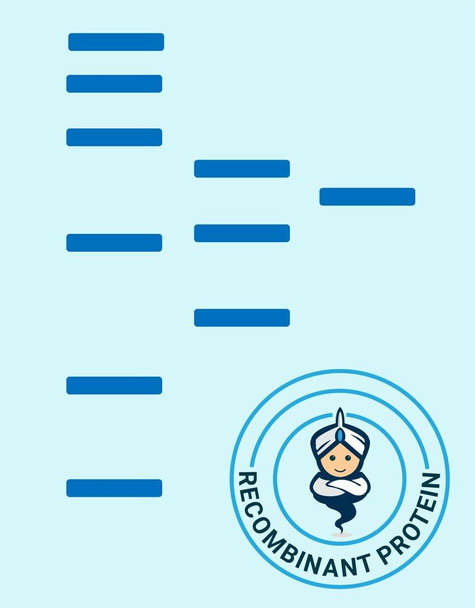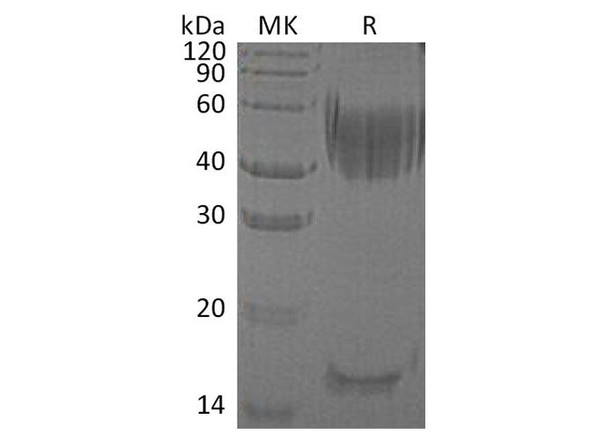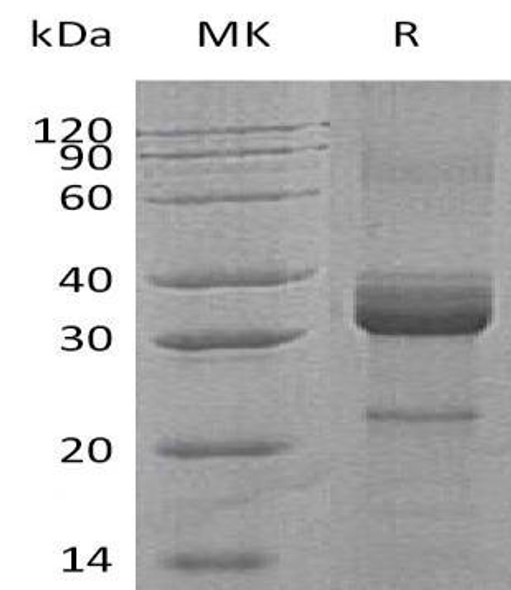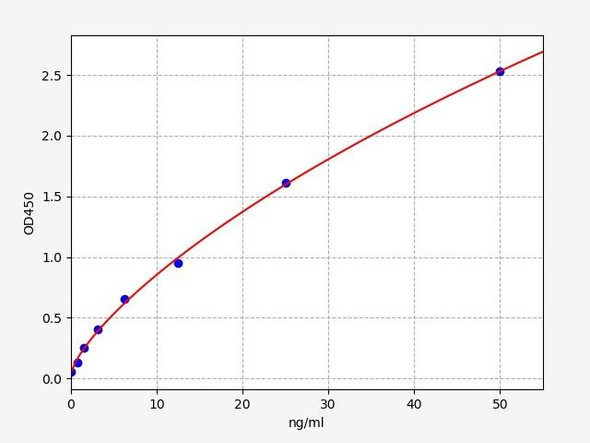Description
| Product Name: | Haptoglobin Recombinant Protein |
| Product Code: | RPPB5891 |
| Size: | 20µg |
| Target: | Haptoglobin |
| Synonyms: | Haptoglobin, HP, BP, HPA1S, MGC111141, HP2-ALPHA-2. |
| Source: | Escherichia Coli |
| Physical Appearance: | Sterile Filtered White lyophilized (freeze-dried) powder. |
| Formulation: | Each mg was lyophilized with 1xPBS, 0.1% SDS and 1mM DTT. |
| Solubility: | It is recommended to reconstitute the lyophilized Haptoglobin in sterile 18M?-cm H2O not less than 100�g/ml, which can then be further diluted to other aqueous solutions. |
| Stability: | Lyophilized Haptoglobin although stable at room temperature for 3 weeks, should be stored desiccated below -18°C. Upon reconstitution Haptoglobin should be stored at 4°C between 2-7 days and for future use below -18°C.For long term storage it is recommended to add a carrier protein (0.1% HSA or BSA).Please prevent freeze-thaw cycles. |
| Purity: | Greater than 90.0% as determined by SDS-PAGE and HPLC. |
Haptoglobin is a glycoprotein which is synthesized in the liver and circulates in the blood. Haptoglobin is produced typically by hepatocytes but also by other tissues: e.g. skin, lung, and kidney. It is a positive acute phase protein that binds free hemoglobin and removes it from the circulation to prevent kidney injury, and iron loss following hemolysis. The haptoglobin-hemoglobin complex is subsequently removed by the reticuloendothelial system (generally the spleen). As the reticuloendothelial system removes the haptoglobin-hemoglobin complex from the body, haptoglobin levels are reduced in hemolytic anaemias. In the course of binding hemoglobin, haptoglobin sequesters the iron inside hemoglobin, preventing iron-utilizing bacteria from benefitting from hemolysis. Haptoglobin consists of two A- and two B-chains, connected by disulfide bonds. Three major haptoglobin phenotypes are known to exist (Hp 1-1, Hp 2-1, and Hp 2-2). Hp 1-1 is biologically the most effective in binding free hemoglobin and suppressing inflammatory responses associated with free hemoglobin. Hp 2-2 is biologically the least active, and Hp 2-1 is moderately active. Haptoglobin�s molecular mass ranges from 8-200 kDa.Reduced levels can be seen in haemolysis and impaired liver function. High levels are a marker for acute or chronic inflammation. Ahaptoglobinemia or hypohaptoglobinemia are caused by mutations in the haptoglobin gene and/or its regulatory regions. Haptoglobin is also linked to diabetic nephropathy, the incidence of coronary artery disease in type 1 diabetes, Crohn's disease, inflammatory disease behavior, primary sclerosing cholangitis, susceptibility to idiopathic Parkinson's disease, and a reduced incidence of Plasmodium falciparum malaria.
Haptoglobin Human Recombinant produced in E.Coli is a single, non-glycosylated, polypeptide chain containing (aa. 145-405) fusion protein with His tag and having a total Mw of 33 kDa (4 kDa His-tag).
| UniProt Protein Function: | HP: Haptoglobin combines with free plasma hemoglobin, preventing loss of iron through the kidneys and protecting the kidneys from damage by hemoglobin, while making the hemoglobin accessible to degradative enzymes. Defects in HP are the cause of anhaptoglobinemia (AHP). AHP is a condition characterized by the absence of the serum glycoprotein haptoglobin. Serum levels of haptoglobin vary among normal persons: levels are low in the neonatal period and in the elderly, differ by population, and can be influenced by environmental factors, such as infection. Secondary hypohaptoglobinemia can occur as a consequence of hemolysis, during which haptoglobin binds to free hemoglobin. Belongs to the peptidase S1 family. |
| UniProt Protein Details: | Protein type:Secreted, signal peptide; Secreted Chromosomal Location of Human Ortholog: 16q22.2 Cellular Component: extracellular space; extracellular region Molecular Function:antioxidant activity; protein binding; hemoglobin binding; catalytic activity Biological Process: receptor-mediated endocytosis; response to hydrogen peroxide; immune system process; metabolic process; defense response to bacterium; negative regulation of oxidoreductase activity; acute-phase response; defense response Disease: Anhaptoglobinemia |
| NCBI Summary: | This gene encodes a preproprotein, which is processed to yield both alpha and beta chains, which subsequently combine as a tetramer to produce haptoglobin. Haptoglobin functions to bind free plasma hemoglobin, which allows degradative enzymes to gain access to the hemoglobin, while at the same time preventing loss of iron through the kidneys and protecting the kidneys from damage by hemoglobin. Mutations in this gene and/or its regulatory regions cause ahaptoglobinemia or hypohaptoglobinemia. This gene has also been linked to diabetic nephropathy, the incidence of coronary artery disease in type 1 diabetes, Crohn's disease, inflammatory disease behavior, primary sclerosing cholangitis, susceptibility to idiopathic Parkinson's disease, and a reduced incidence of Plasmodium falciparum malaria. The protein encoded also exhibits antimicrobial activity against bacteria. A similar duplicated gene is located next to this gene on chromosome 16. Multiple transcript variants encoding different isoforms have been found for this gene. [provided by RefSeq, Oct 2014] |
| UniProt Code: | P00738 |
| NCBI GenInfo Identifier: | 123508 |
| NCBI Gene ID: | 3240 |
| NCBI Accession: | P00738.1 |
| UniProt Secondary Accession: | P00738,P00737, Q0VAC4, Q0VAC5, Q2PP15, Q3B7J0, Q6LBY9 Q9UC67, B0AZL5, |
| UniProt Related Accession: | P00738 |
| Molecular Weight: | |
| NCBI Full Name: | Haptoglobin |
| NCBI Synonym Full Names: | haptoglobin |
| NCBI Official Symbol: | HP�� |
| NCBI Official Synonym Symbols: | BP; HPA1S; HP2ALPHA2�� |
| NCBI Protein Information: | haptoglobin; zonulin; binding peptide; haptoglobin alpha(1S)-beta; haptoglobin alpha(2FS)-beta; haptoglobin, beta polypeptide; haptoglobin, alpha polypeptide |
| UniProt Protein Name: | Haptoglobin |
| UniProt Synonym Protein Names: | ZonulinCleaved into the following 2 chains:Haptoglobin alpha chain; Haptoglobin beta chain |
| Protein Family: | Haptoglobin |
| UniProt Gene Name: | HP�� |
| UniProt Entry Name: | HPT_HUMAN |






